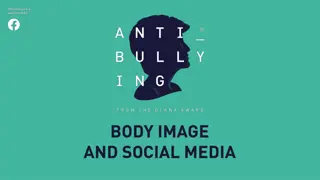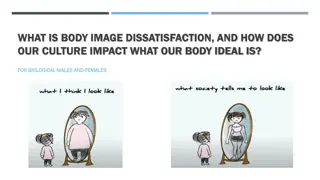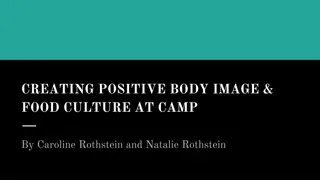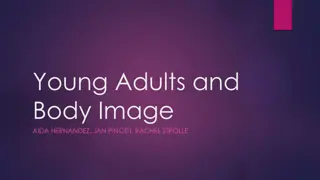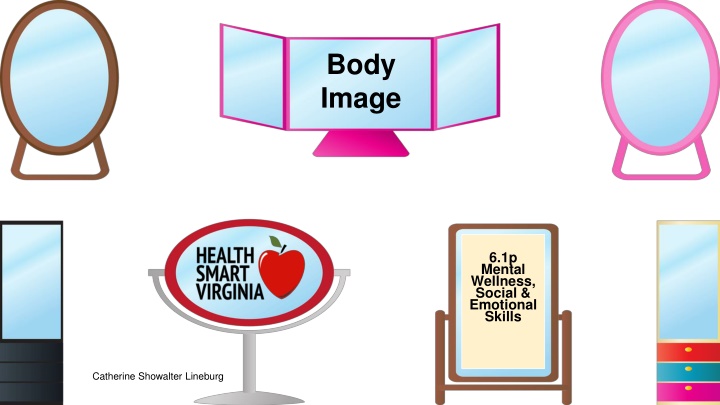
Body Image and Its Impact on Mental Wellness
Explore the concept of body image, its importance, and how it affects mental wellness and social-emotional skills. Dive into activities and discussions to enhance understanding and promote positive self-perception.
Download Presentation

Please find below an Image/Link to download the presentation.
The content on the website is provided AS IS for your information and personal use only. It may not be sold, licensed, or shared on other websites without obtaining consent from the author. If you encounter any issues during the download, it is possible that the publisher has removed the file from their server.
You are allowed to download the files provided on this website for personal or commercial use, subject to the condition that they are used lawfully. All files are the property of their respective owners.
The content on the website is provided AS IS for your information and personal use only. It may not be sold, licensed, or shared on other websites without obtaining consent from the author.
E N D
Presentation Transcript
Body Image 6.1p Mental Wellness, Social & Emotional Skills Catherine Showalter Lineburg
Learning Objectives: I can understand the term body image. I can explain the importance of having a positive body image
Step 1: Introduction Most of us have heard the term, Body Image, but do we really know what that means? Take a minute and write down in the Vocabulary Knowledge Chart what you think is the proper definition of the term, Body Image. Watch the video Talking to Kids About Body Image
Define Body Image Perceptual:How you see your body. Perceptual: How you see your body Body image: The way a person thinks other people look at their own body (positive or negative). Body Image image Body Behavioral: The way you behave as a result of perceptual, affective, cognitive body image. Affective: How you feel about your body. Movement Learning (Say the term and definition while performing the exercise) Affective: How you feel about your body Cognitive: How you think about your body Perceptual: Sky jumps Cognitive:How you think about your body. Affective: Air squats Cognitive: Plank hold Behavioral: Burpee s
Essential Questions: 1. What are some things that you think might affect a person s body image? 2. If a person has a negative body image, what does that mean? 3. Think of an example of how a negative body image might impact a person in their daily life. 4. How might a positive body image impact a person? Watch the following videos Girls 6-18 Talk About Body Image (Girls) Boys Talk About Body Image (Boys)
Activity 1(Individual/Whole group): Watch: What Happens When Strangers Get Real About Body Image Summary of the video: Most people would say that they are their own worst critics, listening too closely to that voice in their heads that judges, mocks, and belittles their appearances, bodies, personalities and lifestyles. But would saying these things aloud to a friend or stranger give you a different perspective on your inner-critic? In the video link above, six people exchange the most painful, critical things they think about their bodies, and try to find ways to be kinder to themselves. Activity 1(Individual/whole group) In what ways are people different from each other? List some of the ways that people are different. (Write responses on the board or paper.) Some things we can change through effort (by studying, practicing, etc.). Some things we can t change, even if we want to (height, eye color, etc.).
Activity 2 (small group or whole group): Some things will change naturally over time whether we want them to or not (height and weight as we grow, preferences, interests, etc). 1. List three things that you are good at? Of these, what are best at? 2. Ask volunteers to tell the group their number 1 item. Then write responses on the board or paper. 3. Discuss that everyone has his or her strengths (and weaknesses). A person s strengths and weaknesses are part of what defines them as a person (these are among our unique qualities). One thing that makes the world interesting is that everyone has his/her own set of unique qualities.
Activity 3 (Partner work): PAIRED VERBAL FLUENCY:For 30-60 seconds student one talks without interruption while student Two only listens, Then repeat again with student number 2 talking and student number 1 listens. Find a partner Decide which partner is #1 and which partner is #2. Round one: Share some traits that you like, that you find to be positive attributes about your partner. Round two: Share some traits/uniques qualities you like about yourself. Was there anything that surprised you that was mentioned by your peers that you do not see in yourself or like about yourself they think is positive about you? How difficult was it to share what you positively like about yourself with a classmate?
Closing Activity I AM Mosaic
Closing Questions: What does the term Body image mean? (Ensure Vocabulary Knowledge Chart has the correct definition.) How can we change the dialogue of our own body image from negative to positive? Why is this important for us to be able to do? Who can recall & show me the movement for the following terms & definitions for the four body images? Perceptual Body Image Affective Body Image Cognitive Body Image Behavioral Image
Lesson Extensions/Connections/Applications Watch I Think You re Beautiful Have students create a positive social experiment to implement and the share with the class at the end of the week . (Individuals, partners, small group, whole class.) ELL Extension: Role-Plays Have students create their own I AM Mosaic to take home or have each student create a positive mosaic YOU ARE for a different student in the class. Have the students create their own fitness exercises to accompany the body image terminology (perception, affective, cognitive, and behavioral.)
Resources/References & Handouts Resources/References Common Sense Education: Body Image Learning for Justice: Body Image & The Media I see you, you see me Positive Body Image Body Activism Handouts Various Body Image Handouts Vocabulary Knowledge Chart



